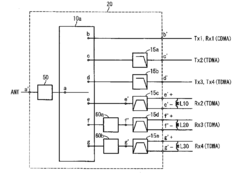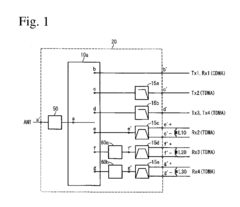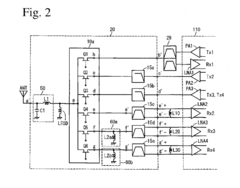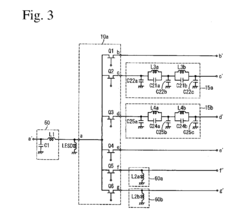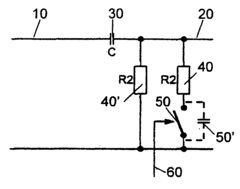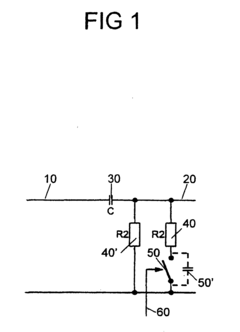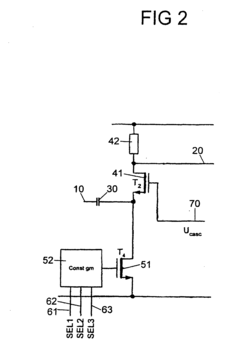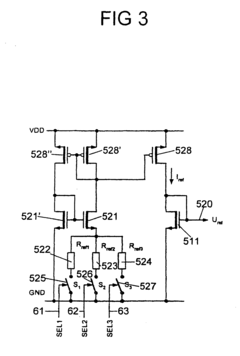High Pass Filter Techniques in Optical Communication System Enhancements
JUL 28, 20259 MIN READ
Generate Your Research Report Instantly with AI Agent
Patsnap Eureka helps you evaluate technical feasibility & market potential.
HPF in Optical Comms
High-pass filters (HPFs) play a crucial role in enhancing optical communication systems by selectively allowing higher frequency signals to pass while attenuating lower frequency components. In optical communications, HPFs are primarily utilized to reduce noise, eliminate unwanted low-frequency interference, and improve overall signal quality.
The evolution of HPF techniques in optical communication systems has been driven by the increasing demand for higher data rates and improved signal integrity. Early implementations relied on simple passive RC circuits, which offered limited performance and flexibility. As technology progressed, more sophisticated approaches emerged, including active filters and digital signal processing techniques.
One significant milestone in HPF development was the introduction of adaptive filtering algorithms. These algorithms dynamically adjust filter parameters based on real-time signal characteristics, enabling more effective noise suppression and signal enhancement. This advancement greatly improved the system's ability to handle varying channel conditions and signal distortions.
Another key development was the integration of HPFs with other signal processing techniques, such as equalization and forward error correction. This holistic approach to signal conditioning allowed for more comprehensive performance optimization, addressing multiple aspects of signal quality simultaneously.
The advent of photonic integrated circuits (PICs) has further revolutionized HPF implementation in optical communication systems. PICs enable the integration of multiple optical and electronic components on a single chip, including HPFs. This integration results in reduced size, lower power consumption, and improved overall system performance.
Recent advancements in HPF techniques have focused on leveraging machine learning and artificial intelligence algorithms. These approaches enable more sophisticated adaptive filtering, capable of learning and predicting channel characteristics to optimize filter performance proactively.
The ongoing evolution of HPF techniques continues to push the boundaries of optical communication system capabilities. Current research efforts are exploring novel materials and structures for implementing HPFs, such as metamaterials and photonic crystals. These innovations promise to deliver even higher levels of performance and functionality in future optical communication systems.
As data rates continue to increase and network architectures become more complex, the role of HPFs in optical communication systems is expected to grow in importance. Future developments are likely to focus on further improving filter adaptability, reducing latency, and enhancing integration with other system components to meet the ever-growing demands of modern communication networks.
The evolution of HPF techniques in optical communication systems has been driven by the increasing demand for higher data rates and improved signal integrity. Early implementations relied on simple passive RC circuits, which offered limited performance and flexibility. As technology progressed, more sophisticated approaches emerged, including active filters and digital signal processing techniques.
One significant milestone in HPF development was the introduction of adaptive filtering algorithms. These algorithms dynamically adjust filter parameters based on real-time signal characteristics, enabling more effective noise suppression and signal enhancement. This advancement greatly improved the system's ability to handle varying channel conditions and signal distortions.
Another key development was the integration of HPFs with other signal processing techniques, such as equalization and forward error correction. This holistic approach to signal conditioning allowed for more comprehensive performance optimization, addressing multiple aspects of signal quality simultaneously.
The advent of photonic integrated circuits (PICs) has further revolutionized HPF implementation in optical communication systems. PICs enable the integration of multiple optical and electronic components on a single chip, including HPFs. This integration results in reduced size, lower power consumption, and improved overall system performance.
Recent advancements in HPF techniques have focused on leveraging machine learning and artificial intelligence algorithms. These approaches enable more sophisticated adaptive filtering, capable of learning and predicting channel characteristics to optimize filter performance proactively.
The ongoing evolution of HPF techniques continues to push the boundaries of optical communication system capabilities. Current research efforts are exploring novel materials and structures for implementing HPFs, such as metamaterials and photonic crystals. These innovations promise to deliver even higher levels of performance and functionality in future optical communication systems.
As data rates continue to increase and network architectures become more complex, the role of HPFs in optical communication systems is expected to grow in importance. Future developments are likely to focus on further improving filter adaptability, reducing latency, and enhancing integration with other system components to meet the ever-growing demands of modern communication networks.
Market Demand Analysis
The market demand for high pass filter techniques in optical communication system enhancements has been steadily growing, driven by the increasing need for higher data transmission rates and improved signal quality. As global internet traffic continues to surge, telecommunications providers and data center operators are seeking advanced solutions to optimize their optical networks.
The optical communication market is projected to expand significantly in the coming years, with a particular focus on technologies that can enhance system performance. High pass filters play a crucial role in this landscape by effectively removing low-frequency noise and improving signal integrity. This demand is further amplified by the rollout of 5G networks and the anticipated growth of 6G technology, which require more sophisticated optical communication systems.
In the enterprise sector, there is a growing need for high-speed, low-latency connections to support cloud computing, big data analytics, and artificial intelligence applications. This has led to increased investment in optical communication infrastructure, including advanced filtering techniques. The financial services industry, in particular, has shown strong interest in high pass filter technologies to minimize latency in high-frequency trading systems.
The telecommunications industry remains a primary driver of market demand for high pass filter techniques. As operators upgrade their networks to accommodate higher bandwidths and longer transmission distances, there is a pressing need for filters that can effectively manage signal dispersion and attenuation. This is especially critical in long-haul fiber optic networks where signal degradation can significantly impact performance.
Emerging technologies such as Internet of Things (IoT) and smart cities are also contributing to the market demand. These applications require robust and reliable communication networks, often operating in challenging environments where signal integrity is paramount. High pass filters can help mitigate interference and ensure consistent data transmission in these complex systems.
The aerospace and defense sectors represent another significant market for high pass filter techniques in optical communications. These industries require highly reliable and secure communication systems, often operating in harsh conditions. Advanced filtering technologies are essential for maintaining clear and interference-free signals in mission-critical applications.
As the demand for higher data rates continues to grow, there is an increasing focus on developing filters that can operate effectively at higher frequencies. This trend is driving research and development efforts towards innovative materials and design techniques that can push the boundaries of filter performance. The market is also seeing a shift towards more integrated solutions, where high pass filters are combined with other optical components to create more compact and efficient systems.
The optical communication market is projected to expand significantly in the coming years, with a particular focus on technologies that can enhance system performance. High pass filters play a crucial role in this landscape by effectively removing low-frequency noise and improving signal integrity. This demand is further amplified by the rollout of 5G networks and the anticipated growth of 6G technology, which require more sophisticated optical communication systems.
In the enterprise sector, there is a growing need for high-speed, low-latency connections to support cloud computing, big data analytics, and artificial intelligence applications. This has led to increased investment in optical communication infrastructure, including advanced filtering techniques. The financial services industry, in particular, has shown strong interest in high pass filter technologies to minimize latency in high-frequency trading systems.
The telecommunications industry remains a primary driver of market demand for high pass filter techniques. As operators upgrade their networks to accommodate higher bandwidths and longer transmission distances, there is a pressing need for filters that can effectively manage signal dispersion and attenuation. This is especially critical in long-haul fiber optic networks where signal degradation can significantly impact performance.
Emerging technologies such as Internet of Things (IoT) and smart cities are also contributing to the market demand. These applications require robust and reliable communication networks, often operating in challenging environments where signal integrity is paramount. High pass filters can help mitigate interference and ensure consistent data transmission in these complex systems.
The aerospace and defense sectors represent another significant market for high pass filter techniques in optical communications. These industries require highly reliable and secure communication systems, often operating in harsh conditions. Advanced filtering technologies are essential for maintaining clear and interference-free signals in mission-critical applications.
As the demand for higher data rates continues to grow, there is an increasing focus on developing filters that can operate effectively at higher frequencies. This trend is driving research and development efforts towards innovative materials and design techniques that can push the boundaries of filter performance. The market is also seeing a shift towards more integrated solutions, where high pass filters are combined with other optical components to create more compact and efficient systems.
Current HPF Challenges
High pass filters (HPFs) in optical communication systems face several significant challenges that hinder their optimal performance and integration. One of the primary issues is the trade-off between filter sharpness and insertion loss. As the filter's cutoff frequency becomes steeper, the insertion loss typically increases, potentially degrading the overall signal quality and reducing the system's power efficiency.
Another challenge lies in achieving wide bandwidth operation while maintaining filter stability. As optical communication systems push towards higher data rates, HPFs must operate over broader frequency ranges. However, maintaining consistent performance across such wide bandwidths proves difficult, often leading to frequency-dependent variations in filter characteristics.
Temperature sensitivity poses a significant hurdle for HPF implementation in optical systems. Fluctuations in ambient temperature can cause shifts in the filter's cutoff frequency and alter its response characteristics. This instability can lead to signal distortion and increased bit error rates, particularly in high-speed communication systems where precise filtering is crucial.
The miniaturization of optical components presents another challenge for HPF design. As the industry moves towards more compact and integrated solutions, reducing the physical size of filters while preserving their performance becomes increasingly difficult. This constraint often leads to compromises in filter characteristics or the need for more complex and costly fabrication processes.
Nonlinear effects in optical fibers and components can also interfere with HPF performance. These effects, such as four-wave mixing and self-phase modulation, can introduce unwanted frequency components that the filter must effectively suppress without affecting the desired signal bandwidth.
Furthermore, the integration of HPFs with other optical components in the signal chain presents compatibility issues. Ensuring seamless operation with various modulators, amplifiers, and detectors while maintaining overall system performance is a complex task that requires careful design considerations and trade-offs.
Lastly, the cost-effectiveness of implementing advanced HPF techniques in large-scale optical communication systems remains a challenge. While novel filter designs may offer superior performance, their practical adoption often depends on balancing improved capabilities with economic viability in commercial deployments.
Another challenge lies in achieving wide bandwidth operation while maintaining filter stability. As optical communication systems push towards higher data rates, HPFs must operate over broader frequency ranges. However, maintaining consistent performance across such wide bandwidths proves difficult, often leading to frequency-dependent variations in filter characteristics.
Temperature sensitivity poses a significant hurdle for HPF implementation in optical systems. Fluctuations in ambient temperature can cause shifts in the filter's cutoff frequency and alter its response characteristics. This instability can lead to signal distortion and increased bit error rates, particularly in high-speed communication systems where precise filtering is crucial.
The miniaturization of optical components presents another challenge for HPF design. As the industry moves towards more compact and integrated solutions, reducing the physical size of filters while preserving their performance becomes increasingly difficult. This constraint often leads to compromises in filter characteristics or the need for more complex and costly fabrication processes.
Nonlinear effects in optical fibers and components can also interfere with HPF performance. These effects, such as four-wave mixing and self-phase modulation, can introduce unwanted frequency components that the filter must effectively suppress without affecting the desired signal bandwidth.
Furthermore, the integration of HPFs with other optical components in the signal chain presents compatibility issues. Ensuring seamless operation with various modulators, amplifiers, and detectors while maintaining overall system performance is a complex task that requires careful design considerations and trade-offs.
Lastly, the cost-effectiveness of implementing advanced HPF techniques in large-scale optical communication systems remains a challenge. While novel filter designs may offer superior performance, their practical adoption often depends on balancing improved capabilities with economic viability in commercial deployments.
Existing HPF Solutions
01 High-pass filter design for improved signal quality
High-pass filters are designed to attenuate low-frequency signals while allowing high-frequency signals to pass through. These filters can be implemented using various circuit configurations and components to enhance signal quality by reducing noise and unwanted low-frequency interference. The design of high-pass filters often involves careful selection of cutoff frequencies and component values to achieve optimal performance for specific applications.- High-pass filter design for improved signal quality: High-pass filters are designed to attenuate low-frequency signals while allowing high-frequency signals to pass through. These filters can be implemented using various circuit configurations to improve signal quality by reducing noise and unwanted low-frequency components. The design of high-pass filters often involves careful selection of components and consideration of cutoff frequencies to achieve optimal performance.
- Digital signal processing techniques for high-pass filtering: Digital signal processing (DSP) techniques are employed to implement high-pass filters in digital systems. These methods involve the use of algorithms and digital circuits to process and filter signals, offering advantages such as programmability and adaptability. DSP-based high-pass filters can be used in various applications, including audio processing, image enhancement, and communication systems.
- Adaptive high-pass filtering for dynamic signal environments: Adaptive high-pass filtering techniques are used to adjust filter characteristics based on changing signal conditions. These methods allow the filter to automatically modify its parameters to maintain optimal performance in dynamic environments. Adaptive high-pass filters can be particularly useful in applications where signal properties may vary over time, such as in wireless communication systems or audio processing.
- High-pass filtering in image and video processing: High-pass filtering techniques are applied in image and video processing to enhance details and improve overall image quality. These filters can be used to sharpen edges, remove low-frequency noise, and extract high-frequency information from visual data. Applications include digital cameras, video surveillance systems, and medical imaging equipment.
- Integration of high-pass filters in communication systems: High-pass filters are integrated into various communication systems to improve signal quality and reduce interference. These filters can be used in transmitters and receivers to remove unwanted low-frequency components, suppress noise, and enhance the overall performance of the communication link. Applications include wireless networks, satellite communications, and optical communication systems.
02 Digital signal processing techniques for high-pass filtering
Digital signal processing (DSP) techniques are employed to implement high-pass filters in digital systems. These methods involve the use of algorithms and digital circuitry to process and filter signals, offering advantages such as programmability, flexibility, and improved precision. DSP-based high-pass filters can be easily integrated into various electronic devices and systems, allowing for real-time signal processing and adaptive filtering capabilities.Expand Specific Solutions03 High-pass filter applications in communication systems
High-pass filters play a crucial role in communication systems by improving signal quality and reducing interference. They are used in various stages of signal processing, including transmitters, receivers, and intermediate frequency (IF) stages. These filters help to eliminate low-frequency noise, DC offsets, and other unwanted components that can degrade the overall performance of communication systems.Expand Specific Solutions04 Integration of high-pass filters in imaging and video systems
High-pass filters are incorporated into imaging and video systems to enhance image quality and improve signal processing. These filters are used to sharpen edges, remove low-frequency noise, and enhance high-frequency details in images and video signals. The integration of high-pass filters in these systems contributes to better overall image clarity and resolution.Expand Specific Solutions05 Adaptive high-pass filtering techniques
Adaptive high-pass filtering techniques involve dynamically adjusting filter parameters based on input signal characteristics or system requirements. These methods allow for real-time optimization of filter performance, adapting to changing signal conditions and environmental factors. Adaptive high-pass filters can provide improved signal quality and noise reduction in various applications, including audio processing, communications, and sensor systems.Expand Specific Solutions
Key Industry Players
The high pass filter techniques in optical communication system enhancements market is in a growth phase, driven by increasing demand for high-speed data transmission and network capacity. The market size is expanding rapidly, with key players like Ciena Corp., Nokia, and Ericsson leading technological advancements. These companies are investing heavily in R&D to improve filter performance and integration. Emerging players such as II-VI Delaware and Lumentum Operations are also making significant contributions, particularly in component-level innovations. The technology is maturing, with a focus on miniaturization, power efficiency, and compatibility with next-generation optical networks. However, there's still room for breakthrough innovations in areas like tunable filters and integrated photonics.
Telefonaktiebolaget LM Ericsson
Technical Solution: Ericsson has developed advanced high-pass filter techniques for optical communication systems as part of their Radio System portfolio. Their approach focuses on integrating high-pass filters with their microwave backhaul solutions, enabling seamless coexistence of optical and radio frequency technologies[10]. Ericsson's filters utilize advanced materials and fabrication techniques to achieve high Q-factors and low insertion loss. The company has also implemented software-defined networking (SDN) principles to dynamically adjust filter characteristics based on network traffic patterns and interference conditions[11]. Ericsson's high-pass filters are designed to support both traditional and packet-based fronthaul/backhaul architectures, providing flexibility for evolving network deployments[12].
Strengths: Integration with microwave backhaul solutions, support for diverse network architectures. Weaknesses: May be optimized primarily for mobile network applications, potentially less suitable for pure optical networks.
Ciena Corp.
Technical Solution: Ciena has developed advanced high-pass filter techniques for optical communication systems, focusing on wavelength-selective switches (WSS) and reconfigurable optical add-drop multiplexers (ROADM). Their solution incorporates liquid crystal on silicon (LCoS) technology for precise wavelength filtering and routing[1]. The company has also implemented machine learning algorithms to optimize filter performance and adapt to changing network conditions[2]. Ciena's high-pass filters are designed to work in conjunction with their WaveLogic coherent optical processors, enabling seamless integration with their existing optical transport solutions[3].
Strengths: Highly integrated with existing product line, adaptive filtering capabilities. Weaknesses: May require specialized hardware, potentially higher cost compared to simpler solutions.
Core HPF Innovations
High-frequency circuit, high-frequency device, and multiband communications apparatus
PatentActiveUS20110260806A1
Innovation
- A high-frequency circuit with a single-pole, multi-throw switch circuit incorporating a first matching circuit featuring a series-connected inductance element and a grounded capacitance element, along with filter circuits and LC filter circuits, to maintain standardized impedance and reduce impedance differences between signal paths.
Switchable high-pass configuration and an optical receiver with a switchable high-pass configuration
PatentInactiveUS20070001755A1
Innovation
- A switchable high-pass filter arrangement using a transistor circuit in common-gate or common-base connection with a capacitive component and a programmable device to set the operating current, eliminating the need for changeover switches in the signal path and reducing parasitic capacitances.
Optical System Design
Optical system design plays a crucial role in enhancing the performance of high pass filter techniques in optical communication systems. The design process involves careful consideration of various components and their interactions to achieve optimal signal transmission and filtering.
One of the key aspects of optical system design for high pass filtering is the selection and integration of appropriate optical components. This includes choosing suitable light sources, such as lasers or LEDs, that can produce signals within the desired frequency range. Additionally, the design must incorporate high-quality optical fibers capable of transmitting signals with minimal loss and dispersion.
The implementation of optical amplifiers is another critical element in the system design. These components are essential for maintaining signal strength over long distances and compensating for losses incurred during transmission. Erbium-doped fiber amplifiers (EDFAs) are commonly used in optical communication systems due to their ability to amplify signals in the 1550 nm wavelength range, which is ideal for long-distance transmission.
Optical filters are at the heart of the high pass filtering technique. The design must carefully consider the filter characteristics, including cut-off frequency, roll-off rate, and insertion loss. Fiber Bragg gratings (FBGs) and thin-film filters are popular choices for implementing high pass filters in optical systems due to their flexibility and high performance.
The integration of optical modulators and demodulators is crucial for encoding and decoding information onto the optical carrier. Advanced modulation schemes, such as quadrature amplitude modulation (QAM) or phase-shift keying (PSK), can be employed to increase data transmission rates and spectral efficiency.
Optical system design also involves the careful management of dispersion and nonlinear effects. Dispersion compensation modules (DCMs) may be incorporated to mitigate chromatic dispersion, which can cause signal distortion over long distances. Additionally, the design must account for nonlinear effects such as self-phase modulation (SPM) and cross-phase modulation (XPM), which can impact signal quality at high power levels.
The overall system architecture must be optimized to ensure seamless integration of all components. This includes designing efficient optical interconnects, minimizing coupling losses, and implementing appropriate power budgeting throughout the system. Advanced techniques such as wavelength division multiplexing (WDM) can be employed to increase the overall capacity of the optical communication system.
Finally, the optical system design must incorporate robust monitoring and control mechanisms. This includes implementing optical performance monitoring (OPM) techniques to continuously assess signal quality and system performance. Adaptive equalization and forward error correction (FEC) algorithms can be integrated to enhance system reliability and maintain high-quality transmission under varying conditions.
One of the key aspects of optical system design for high pass filtering is the selection and integration of appropriate optical components. This includes choosing suitable light sources, such as lasers or LEDs, that can produce signals within the desired frequency range. Additionally, the design must incorporate high-quality optical fibers capable of transmitting signals with minimal loss and dispersion.
The implementation of optical amplifiers is another critical element in the system design. These components are essential for maintaining signal strength over long distances and compensating for losses incurred during transmission. Erbium-doped fiber amplifiers (EDFAs) are commonly used in optical communication systems due to their ability to amplify signals in the 1550 nm wavelength range, which is ideal for long-distance transmission.
Optical filters are at the heart of the high pass filtering technique. The design must carefully consider the filter characteristics, including cut-off frequency, roll-off rate, and insertion loss. Fiber Bragg gratings (FBGs) and thin-film filters are popular choices for implementing high pass filters in optical systems due to their flexibility and high performance.
The integration of optical modulators and demodulators is crucial for encoding and decoding information onto the optical carrier. Advanced modulation schemes, such as quadrature amplitude modulation (QAM) or phase-shift keying (PSK), can be employed to increase data transmission rates and spectral efficiency.
Optical system design also involves the careful management of dispersion and nonlinear effects. Dispersion compensation modules (DCMs) may be incorporated to mitigate chromatic dispersion, which can cause signal distortion over long distances. Additionally, the design must account for nonlinear effects such as self-phase modulation (SPM) and cross-phase modulation (XPM), which can impact signal quality at high power levels.
The overall system architecture must be optimized to ensure seamless integration of all components. This includes designing efficient optical interconnects, minimizing coupling losses, and implementing appropriate power budgeting throughout the system. Advanced techniques such as wavelength division multiplexing (WDM) can be employed to increase the overall capacity of the optical communication system.
Finally, the optical system design must incorporate robust monitoring and control mechanisms. This includes implementing optical performance monitoring (OPM) techniques to continuously assess signal quality and system performance. Adaptive equalization and forward error correction (FEC) algorithms can be integrated to enhance system reliability and maintain high-quality transmission under varying conditions.
Signal Processing Tech
Signal processing techniques play a crucial role in enhancing the performance of optical communication systems, particularly in the context of high pass filter applications. These techniques are essential for improving signal quality, reducing noise, and optimizing overall system efficiency.
One of the primary signal processing methods employed in optical communication systems is digital filtering. High pass filters, implemented through digital signal processing algorithms, effectively remove low-frequency noise and unwanted signal components. This process helps to sharpen the edges of optical pulses, reducing intersymbol interference and improving the overall signal-to-noise ratio.
Advanced modulation schemes, such as quadrature amplitude modulation (QAM) and phase-shift keying (PSK), are often used in conjunction with high pass filtering techniques. These modulation methods allow for higher data rates and improved spectral efficiency. By combining sophisticated modulation with high pass filtering, optical communication systems can achieve better performance in terms of data transmission capacity and signal integrity.
Adaptive equalization is another critical signal processing technique that complements high pass filtering in optical communication systems. Adaptive equalizers dynamically adjust their parameters to compensate for channel impairments and signal distortions. This adaptive approach ensures optimal system performance across varying channel conditions and helps mitigate the effects of chromatic dispersion and polarization mode dispersion.
Machine learning algorithms are increasingly being applied to signal processing in optical communications. These algorithms can be used to optimize filter parameters, predict channel characteristics, and enhance overall system performance. By leveraging machine learning techniques, high pass filters can be dynamically tuned to adapt to changing network conditions and traffic patterns.
Coherent detection techniques, combined with digital signal processing, have revolutionized optical communication systems. These methods enable the recovery of both amplitude and phase information from the received optical signal. High pass filtering plays a crucial role in coherent detection systems by helping to eliminate low-frequency noise and improve the accuracy of phase estimation algorithms.
The integration of high pass filtering with forward error correction (FEC) coding schemes further enhances the reliability of optical communication systems. FEC techniques, when used in conjunction with advanced filtering methods, can significantly improve the system's ability to detect and correct transmission errors, leading to lower bit error rates and increased system robustness.
As optical communication systems continue to evolve, the role of signal processing techniques, including high pass filtering, will become increasingly important. Future developments in this field are likely to focus on the integration of artificial intelligence, advanced DSP algorithms, and novel filter designs to push the boundaries of system performance and efficiency.
One of the primary signal processing methods employed in optical communication systems is digital filtering. High pass filters, implemented through digital signal processing algorithms, effectively remove low-frequency noise and unwanted signal components. This process helps to sharpen the edges of optical pulses, reducing intersymbol interference and improving the overall signal-to-noise ratio.
Advanced modulation schemes, such as quadrature amplitude modulation (QAM) and phase-shift keying (PSK), are often used in conjunction with high pass filtering techniques. These modulation methods allow for higher data rates and improved spectral efficiency. By combining sophisticated modulation with high pass filtering, optical communication systems can achieve better performance in terms of data transmission capacity and signal integrity.
Adaptive equalization is another critical signal processing technique that complements high pass filtering in optical communication systems. Adaptive equalizers dynamically adjust their parameters to compensate for channel impairments and signal distortions. This adaptive approach ensures optimal system performance across varying channel conditions and helps mitigate the effects of chromatic dispersion and polarization mode dispersion.
Machine learning algorithms are increasingly being applied to signal processing in optical communications. These algorithms can be used to optimize filter parameters, predict channel characteristics, and enhance overall system performance. By leveraging machine learning techniques, high pass filters can be dynamically tuned to adapt to changing network conditions and traffic patterns.
Coherent detection techniques, combined with digital signal processing, have revolutionized optical communication systems. These methods enable the recovery of both amplitude and phase information from the received optical signal. High pass filtering plays a crucial role in coherent detection systems by helping to eliminate low-frequency noise and improve the accuracy of phase estimation algorithms.
The integration of high pass filtering with forward error correction (FEC) coding schemes further enhances the reliability of optical communication systems. FEC techniques, when used in conjunction with advanced filtering methods, can significantly improve the system's ability to detect and correct transmission errors, leading to lower bit error rates and increased system robustness.
As optical communication systems continue to evolve, the role of signal processing techniques, including high pass filtering, will become increasingly important. Future developments in this field are likely to focus on the integration of artificial intelligence, advanced DSP algorithms, and novel filter designs to push the boundaries of system performance and efficiency.
Unlock deeper insights with Patsnap Eureka Quick Research — get a full tech report to explore trends and direct your research. Try now!
Generate Your Research Report Instantly with AI Agent
Supercharge your innovation with Patsnap Eureka AI Agent Platform!
